50 Griz Greats
In Service to UM, Their State, Their Country, And The World
by Joan Melcher “The Montanan is proud
to present fifty of the
University’s greatest
alumni and faculty. There are
many others who could be
included here and narrowing the
list down to fifty was difficult.
Criteria included that individuals
were known on the national stage
for their work or made a
significant contribution to the
University over several decades.
Selection was made by a
committee composed of Charles
Johnson ’70, M.A. ’78, director
of the Lee State Bureau; Charles
Hood ’61, M.A. ’69, former dean
of the UM School of Journalism;
Ginny Merriam, Missoulian
reporter; Rita Munzenrider ’83,
Montanan publisher; and Joan
Melcher ’73, Montanan editor.
Brianne Burrowes ’07 contributed
to the research for this
story.
“The Montanan is proud
to present fifty of the
University’s greatest
alumni and faculty. There are
many others who could be
included here and narrowing the
list down to fifty was difficult.
Criteria included that individuals
were known on the national stage
for their work or made a
significant contribution to the
University over several decades.
Selection was made by a
committee composed of Charles
Johnson ’70, M.A. ’78, director
of the Lee State Bureau; Charles
Hood ’61, M.A. ’69, former dean
of the UM School of Journalism;
Ginny Merriam, Missoulian
reporter; Rita Munzenrider ’83,
Montanan publisher; and Joan
Melcher ’73, Montanan editor.
Brianne Burrowes ’07 contributed
to the research for this
story.
 William “Daddy” Aber (1848-1919)
Faculty: 1895-1919
William “Daddy” Aber (1848-1919)
Faculty: 1895-1919
One of William Aber’s passions was to beautify UM’s early campus, established more than a mile from downtown Missoula on a treeless plain. One of the ways he did this was to dig up trees on Mount Sentinel and plant them on campus. Educated at Yale and Cornell Universities, William Aber was one of UM’s first four faculty members. He taught Latin and Greek to the University’s first students, the majority of whom were in preparatory classes and were thirteen to seventeen years of age. He made notable contributions to the community and the state and was a self-appointed custodian of the campus. President Craighead initiated Aber Day in 1915 in his honor—a day in the spring designated for campus cleanup and planting of shrubs and trees by students and faculty.
 Earl Douglass 1899 (1862-1931)
Earl Douglass 1899 (1862-1931)
Ten years after receiving UM’s first master’s degree in geology, paleontologist Earl Douglass discovered a huge cache of dinosaur bones along the Green River north of Jensen, Utah, soon after named the Douglass Quarry. Work at the quarry was financed by Andrew Carnegie, who was looking for a new and impressive exhibit for his museum. Through a fifteen-year excavation (1909-1924) the site yielded more than 350 tons of fossils and attached rock, which were shipped first by horse-drawn wagon and then by railroad boxcars to the Carnegie Museum in Pittsburg. In 1915 President Woodrow Wilson proclaimed the site the Dinosaur National Monument. Many of Douglass’ techniques are still in use today, including the tools he used and his grid-mapping systems.
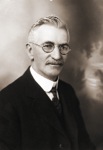 Morton J. Elrod, Hon. LL.D. ’38 (1863-1953) Faculty: 1897-1934
Morton J. Elrod, Hon. LL.D. ’38 (1863-1953) Faculty: 1897-1934
Morton Elrod was a Renaissance man who played a key role in establishing several of western Montana’s lasting treasures. He came to UM in 1897 as head of the science department, teaching seven subjects, including photography. He established the University’s first science collections and helped start the Montana Kaimin and student government association. He led in the creation of the UM Biological Station on Flathead Lake (1899) and helped locate the site for the bison range, now the National Bison Range at Moiese. Elrod was instrumental in the naming of Glacier as a national park and was its first naturalist. He operated Missoula’s first weather station from his home. The unofficial photographer of the campus, his photos document the first two decades of the twentieth century.
 Arthur Stone (1865-1945)
Faculty: 1914-42
Arthur Stone (1865-1945)
Faculty: 1914-42
Well-loved by UM’s first journalism students, Dean Arthur Stone’s memory lives on in the J-School’s Dean Stone Night and Dean Stone Scholarships. Stone worked for the Anaconda Standard and the Missoulian before being named dean of UM’s fledgling journalism school in 1914. He held classes the first year in army surplus tents; other housing included a bicycle shed and war barracks before the Journalism Building was completed in 1936. During his tenure Stone strove to ensure the school was turning out journalists trained in the practical skills of reporting and editing with a strong liberal arts education. Four other ‘Greats’ named here were his students—Streit, Guthrie, Johnson, and Haugland.
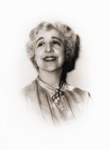 Jeannette Rankin, 1902 (1880-1973)
Jeannette Rankin, 1902 (1880-1973)
It is well-known that Jeannette Rankin was the first woman elected to the U.S. Congress—in 1916 to represent Montana’s western district before women had the vote nationally—and that she voted against entry into both world wars. Less known is her work for women and children, her efforts to make government more responsive, and her lifelong passion to create a culture of peace. Rankin came from a privileged family, but chose to live her life in voluntary simplicity—in a small house without running water or electricity in rural Georgia. In 1968 at the age of 87, she led a group of 5,000 women in protest against the Vietnam War in Washington DC. The Jeannette Rankin Foundation in Athens, Georgia, and the Jeannette Rankin Peace Center in Missoula are part of her legacy.
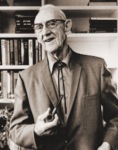 H.G. Merriam, ’63 Hon. L.D. (1883-1980)
Faculty: 1919-54
H.G. Merriam, ’63 Hon. L.D. (1883-1980)
Faculty: 1919-54
UM English Professor H.G. Merriam was a leader in encouraging students to draw from their region and experiences to create an American voice in literature, more particularly a western voice. To encourage his students to write, he launched a magazine, Frontier, where many of their works were published. The creative writing program he established at the University is nationally recognized today. One of the first group of Rhodes Scholars, Merriam received two degrees from Oxford University and taught at various colleges before joining the UM faculty. With his help and encouragement, sixteen UM students became Rhodes Scholars. He also penned the only official history of UM, published in 1970.
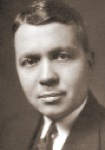 Harold Urey, ’17, Hon. Sc.D. ’35
(1893-1981) Faculty: 1919-21
Harold Urey, ’17, Hon. Sc.D. ’35
(1893-1981) Faculty: 1919-21
Harold Urey’s contributions to science range from playing a role in splitting the atom to charting ocean temperatures. He received the Nobel Prize in Chemistry in 1934 for his discovery of heavy hydrogen or deuterium. Although he was a pacifist, Urey directed isotope separation studies for the Manhattan Project. After the war he devised methods to estimate the temperature of the ocean as far back as 180 million years. Later he investigated properties of the Earth’s early atmosphere and the origin of the solar system. Urey taught chemistry at UM and at Johns Hopkins and Columbia Universities. An advocate of nuclear arms control, he worked actively with other scientists to prevent nuclear proliferation.
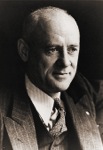 Clarence Streit B.A. ’19, Hon. LL.D ’39
(1896-1986)
Clarence Streit B.A. ’19, Hon. LL.D ’39
(1896-1986)
A correspondent for The New York Times, Clarence Streit covered international affairs in Europe in the 1920s and ’30s. In 1939, discouraged by the inadequacies of the international system to avoid the coming world war, Streit wrote Union Now, the first of a series of books that called for leading democratic nations to form a federal union. He was nominated for the Nobel Prize for this work. His writings encouraged a federalist movement that included support from several world leaders. In 1950 he was the subject of a Time magazine cover story, which compared his life work to that of the century’s leading reformers. Although the federalist movement proposed by Streit waned in this country, it contributed to a cultural and financial integration of European nations.
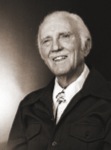 John Lester (1899-1994)
Faculty: 1939-72
John Lester (1899-1994)
Faculty: 1939-72
John Lester trained some of the most successful vocalists of the past century, including sopranos Judith Blegen and Marilyn Zschau and tenors Donald George and Ontoniel Gonzaga. Many of his students credit their careers to him. Zschau called him an “angel on earth.” A talented vocalist himself, Lester studied, sang, and taught opera in Europe and maintained a studio in New York City before coming to UM in 1939. His teaching method was a technical approach aimed at aligning the physical elements of the voice to produce the best sound while also nurturing the spirit of the artist. He is remembered for his rendition of the Star Spangled Banner at UM football and bas- ketball games—particularly his ability to reach the high B flat in that song at an advanced age.
 Jessie Bierman ’21, Hon. Sc.D ’67 (1900-1996)
Jessie Bierman ’21, Hon. Sc.D ’67 (1900-1996)
Nationally known for her pioneering work in delivering health care to infants and children, Dr. Jessie Bierman worked in private practice and also served as an instructor in pediatrics at the University of California School of Medicine (1927-36) before returning to Montana, where she started well-baby clinics that were a model for programs across the country. Other career highlights were a twenty-year professorship at UC Berkeley’s School of Public Health and her classic study, The Children of Kawai, which formed the basis for early childhood intervention programs. One of Bierman’s legacies is the research chair she endowed at the Flathead Lake Biological Station, where she had studied with Professor Morton Elrod.
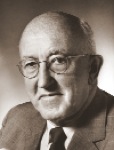 William Allen, ’22, Hon. LL.D. ’54 (1900-1985)
William Allen, ’22, Hon. LL.D. ’54 (1900-1985)
Commercial aviation as we know it today is largely the result of several decisions made by William Allen, who attributed his business sense partially to selling cherries from his mother’s orchard in Lolo. He became legal counsel for Boeing Aircraft at the age of twenty-five and reluctantly took the reins of the company after the death of its CEO in 1944. With the cancellation of federal airplane contracts after the war, Boeing laid off 87 percent of its workforce. Allen’s knowledge of aviation led him to gamble on the idea of commercial jets for transport. The 707 was put into service in 1958. The 727, 737, and 747 followed and when Allen retired in 1968 the company that had been worth $13 million in 1944 was worth $3.3 billion.
 G.P. “Jiggs” Dahlberg ’25 (1900-1993)
Coach & Administrator: 1937-42, 44-70
G.P. “Jiggs” Dahlberg ’25 (1900-1993)
Coach & Administrator: 1937-42, 44-70
Coach Jiggs Dahlberg holds the record for men’s basketball wins at UM—212. He started his sports career at UM as a walk-on football player, weighing 140 pounds, and left it decades later with six varsity letters and a notable career as Griz coach, athletic director, and sports historian. Along the way he became known for his humor as well as his discipline as a coach. He started the athletic department’s fundraising arm in 1955 with the UM Century Club, which became the Grizzly Athletic Association (now the Grizzly Scholarship Association). And he kept records. His Red Book—a handwritten compilation of statistics, rosters, and pertinent information for each season—charted Grizzly athletics from 1897 to 1980.
 A.B. Guthrie ’23, Hon. Litt. D. ’50
(1901-1991)
A.B. Guthrie ’23, Hon. Litt. D. ’50
(1901-1991)
With publication of The Big Sky in 1946, A.B. (Bud) Guthrie’s authentic western voice signaled a major shift in how the region would be perceived by those outside it as well as those within. This novel and others that followed, including The Way West (winner of a Pulitzer Prize in 1950), were born of extensive research and an ear for the land’s dialect. The first twenty years of Guthrie’s career were spent as a reporter and editor for the Lexington Leader in Kentucky (1926-47). The richness of his body of work—ten novels, many short stories and articles, an autobiography, the Academy Award-winning screenplay Shane, and a children’s book—is more impressive considering he didn’t publish fiction until he was into his forties, much of it after he had returned to his home country near Choteau.
 Mike Mansfield ’33, M.A. ’34, Hon. LL.D. ‘56 (1903-2001) Faculty: 1933-42
Mike Mansfield ’33, M.A. ’34, Hon. LL.D. ‘56 (1903-2001) Faculty: 1933-42
When he was fourteen Mike Mansfield dropped out of school and lied to get into the U.S. Navy in order to serve in the First World War. When he died, he had served thirty-four years in the U.S. Congress, a record sixteen as Senate Majority Leader, been a confidante to six U.S. presidents, and spent eleven years as U.S. ambassador to Japan. Few mortals can claim such a life trajectory. Yet he always said serving the people of Montana was his first priority and becoming a U.S. senator from Montana was his highest ambition. He credited his wife, Maureen, for his success. She encouraged him to complete his high school studies, enroll at UM, and run for political office. He taught classes in history of the Far East at UM before being elected to Congress in 1942.
 “Wild” Bill Kelly ’27 (1905-1931)
“Wild” Bill Kelly ’27 (1905-1931)
Bill Kelly led the Grizzlies as quarterback through several seasons and still holds the record for most touchdowns scored—thirty-one in his college career. The “wild” was added to his name apparently because he took control of games by playing several positions—running for field goals, returning punt passes for touchdowns, tackling players. It was said “he could run wild over his opponents and make them cheer him.” Kelly was an All American in 1923 and 1926 and was named to the College Football Hall of Fame in 1969. After college he played for the Brooklyn Professionals. In one game he gained 325 yards; in another, he threw for four touchdowns; over the season he tallied twelve touchdowns. He also played for the New York Yankees football club and boxed; he fought four even rounds with Tommy Gibbons.
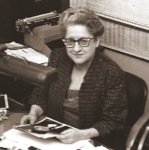 Dorothy Johnson ’28, Hon. L.D. ’73
(1905-1984) Faculty: 1953-67
Dorothy Johnson ’28, Hon. L.D. ’73
(1905-1984) Faculty: 1953-67
Known for her colorful storytelling and painstaking research of the nineteenth century West, Johnson sold her first short story in 1930 (to the Saturday Evening Post) but it was eleven years before she sold another. Johnson took both English and journalism classes at UM, publishing a poem in Frontier, but she worked much of her early life as a journalist—for several years in New York City. In 1950 she returned to her hometown where she reported for the Whitefish Pilot. Her fiction career flourished between 1953 and 1967, with publication of The Man Who Shot Liberty Valance, A Man Called Horse, and many other works. Many of her books were made into films, including The Hanging Tree, which starred fellow Montanan Gary Cooper.
 Joseph Kinsey Howard (1906-1951)
Faculty: 1944-51
Joseph Kinsey Howard (1906-1951)
Faculty: 1944-51
Joseph Howard was not formally educated past secondary school, but his writing on Montana drew him contracts with Yale University Press, grants from the Rockefeller Foundation, and a Guggenheim Fellowship. He began his career as a teenager, reporting for a Great Falls newspaper and soon began writing articles for national publications. His book, Montana: High, Wide, and Handsome (1943), which brought to light the Anaconda Copper Mining Company’s domination of Montana, won him critical acclaim and went into ten printings. Howard then published Montana Margins: A State Analogy, a study of life in Montana’s rural towns. He also published Strange Empire: A Narrative of the Northwest before his death at the age of forty-five.
 Vern Haugland ’31 (1908-1984)
Vern Haugland ’31 (1908-1984)
Vern Haugland reported for Montana newspapers and the Associated Press in Salt Lake City and Los Angeles before volunteering for overseas duty as a reporter in the Second World War. Stationed in the Pacific, he was forced to bail out of a B26 bomber over New Guinea and was lost in the jungle for forty-seven days. His book, Letter from New Guinea, recounted his experiences, for which he was given the Silver Star by General MacArthur in 1943—the first civilian to receive the honor. Haugland became an AP air correspondent and was among a small group of reporters to arrive in Japan after the dropping of atomic bombs. Haugland then covered NASA’s space program at the AP Washington Bureau, where he became known as “the world’s most experienced splashdown reporter.”
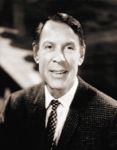 Lowndes Maury ’31, Hon. L.H.D. ’74
(1911-1975)
Lowndes Maury ’31, Hon. L.H.D. ’74
(1911-1975)
Beginning in the 1930s, Lowndes Maury built a career in Hollywood as a pianist, composer-arranger, and conductor. For a time he worked on twelve radio shows simultaneously, including Life with Father and The Life of Riley. He wrote film scores for Universal Pictures and Mr. Magoo cartoons. Maury also composed classical works, including the cantata Proud Music of the Storm for the dedication of UM’s Music Building in 1953; Summer of Green, a rhapsody for alto flute and string orchestra, premiered by the New Zealand National Orchestra; and Variations on a Beethoven Theme, commissioned and recorded by harpsichordist Igor Kipnis. In later years he established the Lou Maury Piano School in North Hollywood where he developed a new approach to music notation.
 Emma Lommasson ’33, M.S. ’39 (1911- )
Emma Lommasson ’33, M.S. ’39 (1911- )
Generations of UM students have experienced the largesse of Emma Lommasson’s character. Stories of her assistance to students are numerous, multi-faceted, and cross-generational. Born in Sand Coulee to Italian immigrants, Lommasson could not spreak English until first grade. She returned to her hometown to teach after graduating, but came back to UM a few years later, beginning a five-decade career at the University. Lommasson assisted in teaching math classes and taught navigation and civil air regulations to Air Force pilots during the Second World War. In 1946 she became assistant registrar and was named registrar in 1973. In 2002 the Lodge was renamed the Emma B. Lommasson Center. She continues a long-standing support for Grizzly teams and notes she is the only person alive who can say they’ve known all but the first four UM presidents.
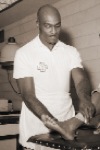 Naseby Rhinehart ’35 (1911-1991)
Staff: 1935-82
Naseby Rhinehart ’35 (1911-1991)
Staff: 1935-82
Naseby Rhinehart came to UM as a student athlete in 1931 and retired fifty-one years later after tallying forty-seven years as its head athletic trainer. Rhinehart excelled on the field himself, winning nine letters in football (All American in 1935), basketball, and track. He was offered the job of UM sports teams trainer one month after his graduation. There were few official trainers at the time and Rhinehart was a pioneer in the field. In 1971 his curriculum for athletic training was published, among the first in the field. He was inducted into the National Athletic Trainer’s Hall of Fame in 1967 and UM’s Naseby Rhinehart scholarship for most inspirational player was established in 1972. The Rhinehart Athletic Treatment Center also bears his name.
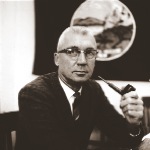 Arnold Bolle ’37 Hon. Sc.D. ’94
(1912-1994) Faculty: 1954-78
Arnold Bolle ’37 Hon. Sc.D. ’94
(1912-1994) Faculty: 1954-78
Arnold Bolle’s work in forestry and soil conservation contributed greatly to the movement to incorporate sustainable methods in forest- management practices. His method of working with farmers and ranchers while employed by the Soil Conservation Service (1938-56) became a national model. Bolle held a fellowship at Harvard University and earned his doctorate there in public administration. He coauthored a report documenting clearcutting practices in the Bitterroot National Forest with six UM colleagues that contributed to the passage of the National Forest Management Act in 1976. The national Bolle Center for Ecosystem Management, a segment of the Wilderness Society, is named for him, as is UM’s Bolle Center for People and Forests.
 Bert Pfeiffer (1915-2004) Faculty: 1959-87
Bert Pfeiffer (1915-2004) Faculty: 1959-87
Bert Pfeiffer’s research of the dangers of radiation from nuclear tests in Nevada in the 1950s was heralded early on as alarmist, as were his warnings about Agent Orange and the environmental impacts of war. In all he was proven right. His research and public speaking on the dangers of nuclear fallout have been cited as contributing to the passage of the Nuclear Test Ban Treaty in 1963. His groundbreaking research of the dangers of Agent Orange was gathered partly by flying with the U.S. Air Force during the war on defoliating raids. An admitted gadfly, Pfeiffer believed in rigorous scientific pursuit as well as the social responsibility of scientists. He joined UM’s zoology department in 1959, teaching anatomy and physiology classes before moving to the environmental studies program.
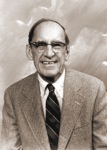 Wayne Rasmussen ‘37 (1915-2004)
Wayne Rasmussen ‘37 (1915-2004)
When Wayne Rasmussen was a young man, he and his brother tried to save the family homestead near Lavina after the death of their father; it was during the Great Depression and they failed. But Rasmussen didn’t abandon agriculture; he just began to study it in another way, becoming the nation’s foremost agricultural historian. After UM he earned two degrees at George Washington University and began his career with the U.S. Department of Agriculture as a records manager in 1937. Twenty-five years later he was named chief historian and when he retired he had served eleven Secretaries of Agriculture over a fifty-year period. He authored, co-authored, or edited some thirty books, including The History of American Agriculture and World Without Hunger, which he ghostwrote with Orville Freeman.
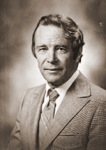 John J. Craighead, Hon. Sc.D. ’94
(1916- ) Faculty: 1952-77
John J. Craighead, Hon. Sc.D. ’94
(1916- ) Faculty: 1952-77
John Craighead and his twin brother, Frank, accomplished groundbreaking work in wildlife biology and contributed to a growing environmental awareness for countless Americans through their National Geographic specials. Their pioneering research of grizzly bears in Yellowstone National Park led to the development of satellite imagery for mapping animal habitat and use of radio telemetry in research. The Craigheads also wrote much of the text for the National Wild and Scenic Rivers Act. Over his years as director of UM’s Montana Cooper- ative Wildlife Research Unit, Craighead studied wildlife and its habitat—from birds to large mammals. He was named one of this century’s eminent scientists by National Geographic and in 2005 UM endowed the John J. Craighead Chair in Wildlife Biology.
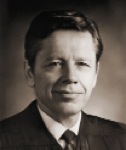 James R. Browning, J.D. ’41,
Hon. LL.D. ’78 (1918- )
James R. Browning, J.D. ’41,
Hon. LL.D. ’78 (1918- )
Senior Circuit Judge James Browning is one of the nation’s longest-serving federal judges and an architect of the modern federal court system in the West. He was nominated by President John F. Kennedy to be circuit judge for the Ninth District in 1961 and was elevated to chief judge in 1976, During his twelve-year tenure as chief judge he became known for reorganizing and modernizing the administration of the circuit as well as for his emphasis on judicial collegiality. In 2004 Congress authorized the naming of the historic U.S. Ninth Circuit Court of Appeals building in his honor and he continues to work with senior status at the court. Earlier in his career, he was a clerk of the U.S. Supreme Court; as such, he held the Bible used to swear President Kennedy into office.
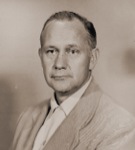 Walter Hook ’42 (1919-1989)
Faculty: 1946-47, 55-77
Walter Hook ’42 (1919-1989)
Faculty: 1946-47, 55-77
Known for a post-war surrealism that placed buffalo and eggs in unlikely technological landscapes and cats in various modes and positions, Walter Hook produced a significant body of work in painting, sculpture, mixed media, and printmaking. His first degrees were in mathematics and he initially taught math classes at UM (1946-1947). Returning to the University with a master’s degree in art from the University of New Mexico, he referred to himself as a “tax-supported welfare recipient euphemistically called a ‘professor of art.’” Over the years he received some ninety awards from juried exhibitions and had more than eighty one-man shows. In 1972 he was elected an Associate of the National Academy of Design, the nation’s oldest artists’ honorary association.
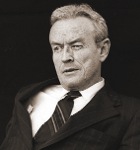 K. Ross Toole ’46, M.A. ’47 (1920-1981)
Faculty: 1965-81
K. Ross Toole ’46, M.A. ’47 (1920-1981)
Faculty: 1965-81
Historian K. Ross Toole began his career as curator of Montana’s historical museum in Helena. Stints as director of the Museum of the City of New York and the Museum of New Mexico followed. He returned to Montana in the early 1960s and became the A.B. Hammond Professor of Western History at UM in 1965. A compelling lecturer, his class, Montana and the West, was legendary at the University, increasing in attendance from eighty students in the late ’60s to a record 954 in 1981. Toole understood the depth and drama of history and was a master at research as well as storytelling. His books—Montana: An Uncommon Land, Twentieth Century Montana: A State of Extremes and The Rape of the Great Plains—are important contributions to Montana history.
 Aline Mosby ’43, Hon. L.D. ’85 (1922-98)
Aline Mosby ’43, Hon. L.D. ’85 (1922-98)
A Missoula native, Aline Mosby graduated from UM and worked as a United Press International reporter in Seattle and then in Los Angeles, where she covered Hollywood. Her colorful and candid stories of celebrities were published in an article for Collier’s magazine in 1956. But she will be remembered more for her work as a foreign correspondent. In 1959 she became the first American woman correspondent posted in Moscow. While there she interviewed Lee Harvey Oswald when he renounced his U.S. citizenship (1959), the first journalist to publish an interview with him. Her forty-year career with UPI included stints in the Paris, New York, and Vienna bureaus. In 1979 she opened the first UPI bureau in Beijing, China, where she won the Bernard J. Cabanes Prize for Journalism.
 Richard Hugo (1923-82) Faculty: 1963-82
Richard Hugo (1923-82) Faculty: 1963-82
Richard Hugo taught creative writing at UM for more than eighteen years, inspiring generations of writers and helping to build a program known nationally for the richness of its literary output. He studied with Theodore Roethke at the University of Washington, then worked as a technical writer for Boeing for thirteen years before his first book of poems was published in 1961. Hugo came to UM soon after and began writing poems that celebrated small and abandoned towns, landscapes, and people of the Inland Northwest. Among his best known works are poems, “Lady of Kicking Horse Reservoir” and “Degrees of Gray in Philipsburg” and books, Good Luck in Cracked Italian and The Right Madness on Skye. The Richard Hugo House for writers in his native Seattle carries on his legacy.
 Kim Williams, M.A. ’81 (1923-1986)
Kim Williams, M.A. ’81 (1923-1986)
The voice of Kim Williams on National Public Radio is something many Americans remember. It was a distinct voice—high and thin with mischief and wisdom in it. Williams had a varied career, including stints as a copy girl for the Los Angeles Examiner and publication of two travel books before coming to Montana in 1971. Her radio/TV class project at UM’s J-School evolved into a local radio show on plants, which led to her ten-and-a-half year career on All Things Considered, where she gave folksy advice and observations on herbs. She was the longest- running guest commentator on NPR. She also published Eating Wild Plants and Kim Williams’ Book of Uncommon Sense. A popular trail near campus was named in her honor.
 Carroll O’Connor, M.A. ’56, Hon.
L.H.D. ’85 (1924-2001)
Carroll O’Connor, M.A. ’56, Hon.
L.H.D. ’85 (1924-2001)
As a UM undergraduate, Carroll O’Connor resigned in protest from the Kaimin when issues were destroyed because of a cartoon poking fun at the Montana Board of Education. Years later his portrayal of Archie Bunker in CBS’s All in the Family would create another controversy. O’Connor’s brilliant rendering of the lovable bigot (1971-79) changed the style and tone of prime time television programming. He studied acting at the National University of Ireland in the 1950s and established himself as a character actor in Hollywood in the ’60s, eventually appearing in thirty films. He received five Emmy awards, eight Emmy nominations, and Golden Globe and Peabody Awards. UM’s O’Connor Center for the Rocky Mountain West is named for him and his wife, Nancy Fields O’Connor.
 Rudy Autio (1926- ) Faculty: 1957-84
Rudy Autio (1926- ) Faculty: 1957-84
When Archie Bray dumped a ton of clay at his ceramic work site near Helena in 1952, it caught sculptor Autio’s attention. Autio had been making bricks for Bray but remained uninterested in ceramics as a medium. However, the sheer volume of the clay allowed him to “think big.” More than fifty years later, Autio’s body of work includes twenty-two architectural artworks, many of them public commissions. A painter and drawer at heart, Autio’s distinctive free-standing sculptures and vessels are known for lyrical representations of horses and nudes, as well as for their glazes. Ceramics Monthly magazine hailed him as one of thirteen living artists who have had the greatest impact on contemporary ceramics. His sculpture of a Grizzly at the entrance to UM’s Oval is known and appreciated by alumni and visitors alike.
 Clarence (Clancy) Gordon (1928-1981)
Faculty: 1960-81
Clarence (Clancy) Gordon (1928-1981)
Faculty: 1960-81
Clancy Gordon was a commercial fisherman for several years before earning degrees from the University of Washington and Washington State University. A prolific author and researcher, Gordon became a national expert on the effects of fluoride emissions and other air pollutants on plants. He was a witness in many legal cases and adversary hearings brought against polluters during the 1960s and ’70s. Gordon’s work involved him in cases across Montana and the country, as well as in Canada and Europe. He founded the Environmental Studies laboratory in 1963 and helped establish the Environmental Studies Graduate Program. The Clancy Gordon Environmental Scholarship is awarded to graduate students for use of scientific knowledge in resolving environmental problems.
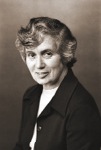 Margery Hunter Brown, ’50, M.A. ’53,
J.D, ’75, Hon L.L.D. ’97 (1928-98)
Faculty: 1976-93
Margery Hunter Brown, ’50, M.A. ’53,
J.D, ’75, Hon L.L.D. ’97 (1928-98)
Faculty: 1976-93
For nearly two decades she was known in the UM law school simply as Marge. Margery Hunter Brown’s work throughout the state in the latter part of the last century became well known but her mentoring of a generation of law students may have been her richer legacy. Brown established the Indian Law Clinic at UM’s law school in 1980, which resulted in major code revision projects on reservations across the state, and she co-authored several publications on Indian law and politics. Brown also was a leader in the Montana Human Rights Commission and played a significant role in rewriting the state’s constitution in 1972, becoming one of its leading scholars.
 Joe McDonald ’58, M.A. ’65, Ph.D. ’82, Hon D.H.L. ’05 (1933- )
Joe McDonald ’58, M.A. ’65, Ph.D. ’82, Hon D.H.L. ’05 (1933- )
Joe McDonald’s experience as an educator spans elementary to college classes and includes the establishment of extension centers that grew into Blackfeet Community and Salish Kootenai Colleges. McDonald has been president of Salish Kootenai since its founding as a two-year tribal college in 1978. Today the college offers several baccalaureate degrees and draws students from more than forty-five tribes. McDonald is president of the American Indian Higher Education Consortium and serves on the boards of the American Council on Education and the American Indian College Fund. He previously served on the Carnegie Foundation for the Advancement of Teaching and the Ford Foundation’s Rural Community College Initiative.
 Don Read (1933- ) Coach: 1986-96
Don Read (1933- ) Coach: 1986-96
The most successful football coach in UM’s history (85-36), Don Read tallied ten straight winning seasons during his tenure and ten straight victories over the MSU Bobcats. In 1995 he led the Grizzlies to their first Division I-AA national championship, beating Marshall University 22-20. He also coached at Portland State, the University of Oregon, and Oregon Tech. His twenty-six-year record in coaching at the college level is 154-127-1. Read was named Coach of the Year in three college football conferences and was an NCAA Regional Coach of the Year twice. He has published several articles and books, including Football Tales and The Complete Passing Game. He retired from coaching in 1996, but returned to UM temporarily to lead the athletic department through trying budgetary times during 2004.
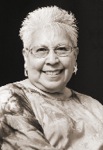 Henrietta Mann (1934- )
Faculty: 1977-2000
Henrietta Mann (1934- )
Faculty: 1977-2000
Henrietta Mann’s thirty-five years as an American Indian educator reached a peak when she was named the first person to hold the Endowed Chair in Native American Studies at Montana State University. Mann was central to the formation of UM’s Native American Studies program in the 1970s. She is known nationally as an educational and spiritual leader. Rolling Stone magazine named her in its Honor Roll of Ten Top Professors in 1991; she also has held the titles of Cheyenne Indian of the Year and National American Indian Woman of the Year. Mann has been a consultant for several television and movie productions and served on many national boards, including the Board of Trustees for the Smithsonian’s National Museum of the American Indian.
 Nancy Erickson, M.A. ’68, M.F.A. ’69 (1935- )
Nancy Erickson, M.A. ’68, M.F.A. ’69 (1935- )
Nancy Erickson’s art transcends mammalian boundaries. She places bears and women in living rooms and lets cougars tell their stories as they gaze into the eye of the viewer. A love for the environment and the people and animals that populate it is central to her vision—largely abstract yet grounded by its intertwining of animal and human lives and a profound empathy therein. Erickson’s work is easily recognized in several mediums—fabric constructions, quilts, drawings, and paintings. In 2003 she won Best of Show Quilt National. Earning her first degrees in zoology and nutrition, Erickson came to art in her thirties, beginning a prolific career that spans four decades. Her work has hung in about 500 exhibitions in this country and around the world and is held in eighteen permanent collections.
 Don Oliver ’58 (1936- ) Faculty: 1998
Don Oliver ’58 (1936- ) Faculty: 1998
In thirty-three years as a broadcast journalist, Don Oliver reported on conflicts in Southeast Asia, the Exxon-Valdez oil spill, Egyptian-Israeli peace talks, and many political conventions. A Billings native, he was an NBC News correspondent for twenty-five years. Oliver covered peace and civil rights marches and the 1968 Democratic National Convention in Chicago before moving to Tokyo in 1973 where he reported on the Far East. In the 1980s he turned to environmental reporting and covered issues such as clear-cutting in national forests, the acquisition of new wilderness areas, and the infamous Berkeley Pit in Butte. He has taught and lectured at UM’s J-School, leading classes in broadcast writing and journalistic ethics. He now works as a media consultant in Los Angeles.
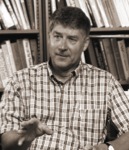 Paul Miller ’61 (1939- ) Faculty: 1969-2005
Paul Miller ’61 (1939- ) Faculty: 1969-2005
Paul Miller earned a national reputation as a policy analyst and advocate for the poor, the hungry, and the homeless. Joining the faculty in 1969, Miller taught and researched at UM for more for thirty-five years. In 1989 he joined the Montana Hunger Coalition and launched the first study of poverty and hunger in Montana. His report included groundbreaking research and was widely read by policymakers; several pieces of legislation followed that addressed the issues of hunger in Montana. State administrators have lauded his “gentle nudges to the conscience.” A much admired and sought after teacher, he took on some of the largest classes offered at UM. In 2001 he was awarded the prestigious Kenneth Wilkinson Rural Policy Award for his body of work.
 James Welch ’65, Hon. D.L. ’97
(1940-2003)
James Welch ’65, Hon. D.L. ’97
(1940-2003)
James Welch’s professor at UM, Richard Hugo, told him to write about what he knew and when he did the lives of American Indians emerged from the page with an unprecedented honesty and literary clarity. His storytelling was rich with imagery and laced with equal measures of comedy and tragedy. Publication of his collection of poems, Riding the Earthboy 40 in 1971 brought Welch his first critical acclaim, followed by Winter in the Blood, reviewed on page one of The New York Times Book Review. Fool’s Crow, Killing Custer, and The Heartsong of Charging Elk were also important works. His books, all still in print, are critically acknowledged in this country and in demand in Europe, particularly in France. He was knighted by the French government in 2000.
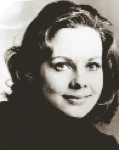 Judith Blegen, Hon. F.A.D.’87 (1940- )
Judith Blegen, Hon. F.A.D.’87 (1940- )
A native of Missoula and a UM student of John Lester, opera soprano Judith Blegen went on to claim stages from Paris to New York to Santa Fe, New Mexico. While still a student at the Curtis Institute of Music in Philadelphia (1959-64) she sang with the Philadelphia Orchestra. In 1963 she went to Italy to study with Luigi Ricci. She sang with the Nuremberg Opera, the Vienna State Opera, at the Salzburg Festival, and with the Santa Fe Opera in a satirical piece written for her. In 1975 she made her first appearance at London’s Covent Garden and in 1977 in the Paris Opera. She made her Metropolitan Opera debut in New York in 1979 as Papagena, returning regularly in subsequent seasons to sing such roles as Zerlina, Marzelline, Gilda, Sophie, Blondchen, and Adele.
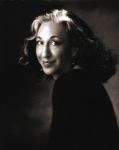 Dana Boussard ’66, M.F.A. ’68 (1944- )
Dana Boussard ’66, M.F.A. ’68 (1944- )
Dana Boussard’s commissioned artwork can be seen in the Anchorage Airport, the Federal Reserve Board in Minneapolis, and AARP Headquarters in Washington DC. Known for her work in textiles, she also has brought her distinctive style to glass art in an architectural environment, drawing images using copper and lead and creating color and texture with hand-rolled glass. Boussard’s textile art shows a painter’s sensibility; she fuses paint, fiber, collage, and texture into dramatic, fluid images that evoke a particular time and place. She has received numerous fellowships and awards and her studio pieces have been hung in museums and galleries across the country. Boussard’s work is held in more than fifty private and public collections.
 Jack Stanford (1947- )
Faculty: 1973-74, 1980-present
Jack Stanford (1947- )
Faculty: 1973-74, 1980-present
Jack Stanford’s contributions to water ecology have not only brought him international acclaim, they have helped save the water systems at his research home. Stanford began studying at the Flathead Lake Biological Station more than thirty years ago. Today he is UM’s Jessie M. Bierman Professor of Ecology and the station’s director. He has studied everything from microbes to grizzly bears, but his main research centers on groundwater and floodplain ecology in Montana, British Columbia, and Kamchatka, Russia. Through these studies, he has identified a wide variety of hypogean animals in groundwater aquifers that contribute to the biodiversity and bioproductivity of water systems. In 2001 he was named a fellow of the American Association of Science for his contributions to freshwater ecology, one of only 251 AAS fellows.
 Monte Dolack ’74 (1950- )
Monte Dolack ’74 (1950- )
Monte Dolack’s art has filled Montana and spilled over into the country and the world. Beginning in the mid ’70s, Dolack began to create finely detailed, whimsical posters depicting such scenes as beavers chewing on log furniture, trout inhabiting bathtubs, and bison in a classroom. A love of the natural world, along with a sense of humor and irony, are at the center of his work, which includes traditional printmaking. Dolack has produced countless posters, including commissioned work for the Nature Conservancy, Defenders of Wildlife, and Bear Trust International. Recently his Dancing Cranes limited edition print was commissioned by UM’s Maureen and Mike Mansfield Center and is in Hokkaido, Japan, one of the few places where the red-crowned crane still exists.
 Larry Krystkowiak ’96 (1964- )
Coach: 2003-present
Larry Krystkowiak ’96 (1964- )
Coach: 2003-present
The leading scorer and rebounder in Griz men’s basketball, Larry Krystkowiak went on to play eleven years of professional basketball, including ten years in the NBA. The twenty-eighth pick in the 1987 draft, he played for several teams, including the San Antonio Spurs, Utah Jazz, Orlando Magic, and Chicago Bulls. During his four years as a Griz, Krystkowiak scored 2,017 points and pulled down 1,105 rebounds. He was the only player in Big Sky history to be named MVP three times and was an Academic All-American in 1985 and 1986. In 1989 he became the only player in UM men’s basketball history to have his number (42) retired. In 2003 he returned to the University to coach the men’s basketball team.
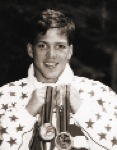 David Berkoff, M.S. ’95, J.D. ’98 (1966- )
David Berkoff, M.S. ’95, J.D. ’98 (1966- )
David Berkoff revolutionized backstroke swimming with his underwater start-and-turn, dubbed the “Berkoff Blastoff.” Along the way, he set four world records and won two Olympic gold medals, one silver, and one bronze in the 100-meter backstroke and 4x 100-meter medley relays. Although not a standout swimmer as a youngster, Berkoff was persistent in his practice and on enrolling at Harvard University trained under Coach Joe Bernal. There he earned the 1987 NCAA national swimming championship, the first won by the university in twenty-six years. (He won it again in 1989). At the 1988 U.S. Olympic Trials, he broke Igor Poliansky’s (URS) 100-meter backstroke world record. He also won three U.S.S. national championships and a silver medal at the 1987 Pan American Games.
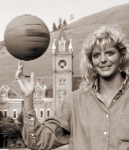 Shannon Cate Schweyen ’93 (1970- )
Coach: 1993-present
Shannon Cate Schweyen ’93 (1970- )
Coach: 1993-present
In her four years as a Lady Griz, Shannon Cate racked up 2,172 points—more than any other Big Sky player, man or woman—and led the Lady Griz to a 103-18 overall record. Schweyen had career highs of forty-one points in a game, nineteen rebounds, and eleven assists—all UM records. She remains the Big Sky Conference’s only Kodak first team All-American. She was a two-time Big Sky MVP and a three-time Big Sky tournament MVP. Her No. 21 jersey was retired following her collegiate career and now hangs in UM’s Hall of Champions. She played for a short time in Vitoria, Spain, following graduation, but a shoulder injury cut short her professional career. She is assistant coach for the Lady Griz.
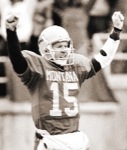 Dave Dickenson ’96 (1970- )
Dave Dickenson ’96 (1970- )
For Grizzly football fans, there has been no greater joy than watching Dave Dickenson’s passing game. In 1995 he outranked every other college quarterback in the nation in passing yards. Dickenson set fourteen Big Sky Conference and NCAA Division I-AA records and twenty-six UM records. He led the Grizzlies to their first national championship win in 1995—earning the Walter Payton Award along the way. Dickenson attended UM on a Presidential Leadership Scholarship and was named to the GTE Academic All-American team in 1995. He played for the Calgary Stampeders in the Canadian Football League and was named Most Valuable Player his second season. Today he quarterbacks for the British Columbia Lions, who had a 12-5 record when we went to press.
The following photos were provided courtesy of UM’s K. Ross Toole Archives: William Aber, Morton J. Elrod, H.G. Merriam, Clarence Streit, John Lester, Jessie Bierman, William Allen, G.P. “Jiggs” Dahlberg, A.B. Guthrie, Mike Mansfield, Dorothy Johnson, Joseph Kinsey Howard, Vern Haugland, Lowndes Maury, Emma Lommasson, Naseby Rhinehart, Arnold Bolle, Wayne Rasmussen, John J. Craighead, James P. Browning, Walter Hook, Kim Williams, Carroll O’Connor, Clancy Gordon, Margery Hunter Brown, K. Ross Toole, Joe McDonald, and Judith Blegen.
Honorary degrees are abbreviated as follows: LL.D. Doctor of Laws; Litt.D. Doctor of Literature; L.H.D. Doctor of Humane Letters; Sc.D. Doctor of Science; and L.D. Doctor of Letters.